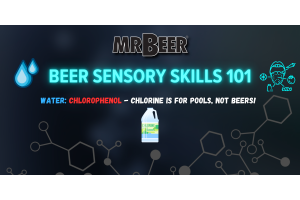33 Brewing Terms Every Homebrewer Should Know

You may hear a lot of brewing terms thrown around all over the place but not quite sure what they mean or what they are. Well we decided we would break it down for, enjoy!
Alpha Acid
The bittering acid that is in hops which is measured as a percentage of weight. The low range for very little bitterness can be from 2%-7% while the high range can be from 13% and up.
Attenuation
Is a measurement of the fermentable sugars in your wort that is converted to alcohol during the fermentation process. The higher the attenuation the higher the ABV will be.
Carboy
Jug with a narrow opening at the top used in primary and secondary fermentation. Ranging in size from 5 to 6-1/2 Gallons and made from glass or plastic.
Cellaring
Method of storing or aging beer at a cooler temperature usually between 50-55 degrees.
Chill Haze
Caused by protein-tannin compounds when a beer is at a cold temperature. The beer appears to have a “haze” when you look through it. Will not affect the taste in your beer.
Color (SRM)
Color is measured in SRM’s or Standard Reference Method units. The measurements are expressed in degrees. The higher the SRM the darker the beer.
Conditioning
Processes of letting your beer sit out at fermentation temperature for an extended period in either bottles or a keg to let the residual yeast continue to clean up any off flavor that may be present. Bringing a beer into condition also includes carbonation.
Diacetyl
A chemical that can be produced during fermentation and is perceived as an off flavor in your beer. It will impart a butterscotch or butter popcorn flavor in the beer.
Esters
Term to describe fruity flavors and aromatics in your beer. For example, in Hefeweizen’s you will get banana aroma, which would be considered an ester.
Fermentation
Process of converting sugar to alcohol and carbon dioxide by adding yeast.
Finishing Hops
Often called aromatic hops, these are added during the final minute of the boil to create hop flavor in your beer. Can also be achieved through dry-hopping by adding hops during or after fermentation.
Flocculation
When yeas clumps together during the fermentation process and moves to either the top or bottom of the fermenter.
Hop Aroma
Something that you can smell when drinking beer. Usually more present in IPA styles, different hops can provide unique aromatic features to your beer.
Hot Break
When proteins and polyphenols clump together during a wort boil and fall to the bottom of the kettle.
IBU’s
International Bitterness Units or IBU’s are a way to measure the bitterness in beer. The higher the bitterness the more bitter flavor in the beer. IPA’s tend to have high IBU’s while Lager’s are usually very low.
Kraeusen
The foamy head that develops on the top of your wort at the beginning of fermentation. The peak of this process called High Kraeusen.
Lager
A style of brewing that is done at a temperature between 40 to 50 degrees uses Lager yeast for a traditional bottom fermenting yeast.
Lagering
Processes of aging a lager beer at a cooler temperature usually between 40 to 50 degrees.
Lautering
Process of removing the grain after the mash. This is can be done with a strainer and may include a hot water rinse of the collected grains which is called sparging.
Lauter-tun
Brewing vessel that is used during the lautering processes to collect the grain.
Malted Barley
Barley that has started to germinate or sprout and then has been dried out through heat to stop the process. During this process sugars and starches are created that will be extracted during the brewing process.
Malt Extract
Comes in liquid or a dried form and can be hopped or un-hopped. During the brewing process when the wort is created it is run through an evaporator to extract water from the solution and condense it down to a syrup or powder.
Mashing
Grain starches are converted into fermentable sugars. This is done by submerging the grain in water at a temperature between 140-160 degrees up to several hours.
Phenolic
An off flavor that can be in your beer. It is often described as medicinal, or Band-Aid like. It can be caused by wild strains of yeast or bacteria.
Pitching
The process of adding yeast to the wort.
Primary Fermentation
The initial stage of fermentation which can make up to 75% of the total fermentation process.
Priming
Adds sugar to either your bottles or into a bucket to batch prime during the bottling process. This is how beer can be naturally carbonated.
Racking
The process of taking your beer from the primary fermenter into a secondary fermenter to continue fermentation or to add special additives. This is often done using an auto-syphon.
Secondary Fermentation
Stage after the beer has been transferred to the secondary fermenter and is the finish stage of fermentation. It is often a less active fermentation and can appear dormant at times.
Specific Gravity
Measurement of liquid as it compares to water using a hydrometer. When brewing, an Original Gravity is taken and at the end, a Final Gravity is taken. This calculates the ABV of your beer and to know when your beer is finished fermenting.
Trub
The substance at the bottom of your fermenter, it is pronounced “troob”. This is a byproduct of the fermentation process. Can also occur in naturally carbonated bottles or kegs.
Wort
The liquid right before you pitch your yeast and pronounced “wert”.
Yeast
Microorganisms that convert fermentable sugars to alcohol and Co2. Different types of yeast create different flavors in your beer.





